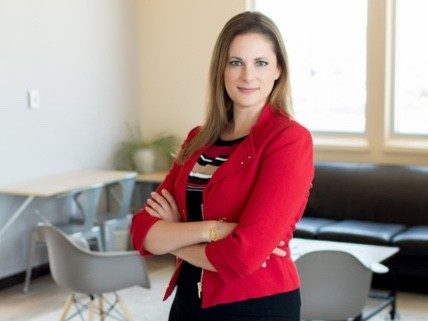When the rest of the world shut down, hospitals had to stay open. Heather Johll is the COO for Ascension, which runs many major hospitals around the United States.
Heather had to find a way to keep her staff safe at home and not allow even a hiccup in the services they provide to hospitals.
“It’s a moment in my career I will never forget.”
Managing exceptions
Heather’s team is made up of humans and bots. She’s got 90 bots running right now and they take on the majority of the workload.
The humans are there to manage all the exceptions.
“Automation has allowed us to become a thought service environment versus a transactional environment…The scale is such that we don’t have an option to move away from automation,” said Heather.
Anyone who is in charge of a large volume of work needs to think this way. Bots take care of the regular and humans manage the exception.
Taking care of the humans
During the crisis, Heather said, “I was able to focus on the quality of the environment for my team because we had already automated so much.”
This is the ideal situation for digital leaders. They should have the space to care and provide comfort for the humans on their team without missing a beat of work.
Continuous process improvement
For Heather, the most important part of her job is the next process improvement her team finds. A single improvement can save millions of dollars.
“I have to be aware that somewhere, there’s someone with an idea that could be worth tens of millions of dollars of savings. How do you pull ideas out of people? How to do prioritize the ideas we have?”
But automation is more than just money. “You can look at automation through hours saved, dollar saved, but there’s also the value add.” Automation enables a richer life for all the people involved.
More from Heather Johll
Today we have a very special guest. We have Heather Johll on the show. She is the VP of operations at Ascension. Hi, Heather. How are you doing today?
Good. How are you?
I’m doing very well. We are in the midst of a very difficult time. Obviously, we have COVID going on. We have a lot of other things in our culture happening right now. But we want to focus on how we’re moving as a culture as a business into digital workspaces. So we wanted to bring you on. You have a lot of experience in a very large organization that you lead the operations for. So why don’t you give a little bit of background about yourself and about Ascension?
My job at Ascension is to run the shared services organization for Ascension. To put that into perspective, Ascension has over 2,600 hospitals and standalone clinics in 20 different states across the United States. What I do and my team does right here in Indianapolis is we make sure that all of the back office functions, all the non patient facing functions, continue to move forward and support the hospitals so that the caregivers can focus in on the mission of Ascension, which is to serve. We focus on the poor, the underserved, and of course, world class healthcare. So, when you think about the gravity of that and what that means, especially as we talk through the times that COVID in the pandemic, when the world needed to shut down and we needed to go home, there couldn’t even be a single hiccup in the functions at the Shared Services Center. Because if there’s a hiccup here, something at the hospital can’t be delivered. And this is a critical time for the hospitals to deliver care and to deliver the right things to our patients to make sure that they’re healthy. So this was, I would say, from a stress and from a is the BCP the right BCP? We are live testing of, it was a moment in my career that I will never forget. And one that now we’ve marched past, and it’s become what I call a new normal. And I think that’s what everyone’s calling it, the new normal.
How would you compare the level of digitization you were like saying February of this year compared to now. We’re recording this in June of 2020. So where were you before? What are some things you were implementing on a digital aspects that were successful? And how have you pushed those things in the last few months?
So there’s a lot of things that I think have helped Ascension from a shared services perspective, and one of the things that we’ve been really cutting edge on is bots automations. Right now, I believe in my center, I have 90 running, which is a very large number when you go out and look at the industry and compare how others function. So that’s helped us from an efficiency perspective prior to all of this happening.
Can you give some examples of what your bots are doing?
Sure. One of the functions that we perform within the center, which is obviously a very huge function, is the month end close. Month end close happens and that happens across every single business that we have, every single hospital that we have, and we have bots that are doing things like, let me give you a good example. Instead of an accountant sitting there and hitting the keyboard and pressing through to get the approvals where they need to be. It’s coming in, it’s reading the email, it’s taking that out of the email, it’s going in, it’s performing the function without us touching it so that we’re only managing exceptions. I think that’s what the automation has allowed us to do is to become a thought service environment versus a transactional environment. So the transactions that are happening within the building, and I could go on and on about this, but it’s mind blowing the hours and the millions and millions of dollars that we’ve saved by staying on the front line of of automation. As we transitioned home, that was one thing I didn’t have to think about was, well, are my transactions going to go from 200 widgets a day down to 150? Those things weren’t things that I had to have on my mind. I was more focused on the quality of the environment that my employees were going to be in, what equipment do we need to provide? What additional services from, we’re in G Suite, which is another unique space for Ascension, which the timing and everything of it was a huge help for us because, as most of us know, because we are all in G Suite at some point in our day, if not professionally, personally. It’s a very nice and clean and personal interface. So we had shifted to that I want to say earlier this year, and so going home with the G Suite applications really provided, from a leadership perspective, which I think that’s what this is all about. Moving from work to home is about leadership, and how you leverage the tools that you have that are existing. People don’t buy a whole bunch of new tools right now and try and do an implementation. You’re going to struggle because there’s too many moving parts and your environment isn’t in front of you anymore. So taking the tools that we had and leveraging those things and then really driving like how do we execute, every meeting I have is a video meeting. Of course, and that’s all of us across the globe, but the frequencies changed. The way that I interact with my employees now is different. I used to walk the building and stop and sit with someone. Now you have to have virtual business hours or I have a monthly all hands meeting where we’ll have 600, 700 people on the line because everyone craves information right now and they want to know what’s the direction? The level of transparency that I’m providing to my team right now is literally as I’m getting information, I’m feeding information so that I can create some comfort for these folks at home because that’s the big adjustment is everybody thinks they want to go home and work until they’re at home working. And then they’re sitting at their desk and it’s not the same and the chair’s not ergonomically correct chair and the monitors don’t fit right and all those little things that you take for granted when you sit down at your desk every day with all the things have been measured and over time and this is the exact height of the desk and this is the exact way the chairs should fit. Those are things now that people have settled in that they’re raising their hand and saying, I need help with this. Can you walk me through how I can be more efficient when the kids are here?
I want to come back to one of the issues you brought up before when you said the difference between thought and transactions, which how you’ve been able to take advantage of the automation, take advantage of the technology. And that frees you up as a leader to then say, okay, my job is now to take care of my people or someone else, their job is not to answer numbers, but their job is to look at exceptions or imagine if, okay, are these the right numbers that we need? That’s a really powerful way to look at how to use technology and automation. What are some other thoughts you have around that or other ways you’ve implemented that difference between enabling the humans that work for you to really be humans?
One of the things that’s come out of that is a real interest in the individual contributors, finding ways to create efficiencies. So you have this continuous improvement culture that’s created. Because it’s a way of life, because instead of me hitting a button 100 times a day, how can I only hit that button 20? And we reward our employees, encourage and require, I would even go as far as to say that, that they’re providing us solutions, ideas, things that we can go and look at and measure and say, yes, I think that this is an automation. Some of it is, honestly, is not a bot. Some of it’s just a process improvement that needs to happen. We like to apply automation bots, all those things to everything. And I think that it’s amazing to watch it work. It’s in the background. You can’t even see it and it’s happening. But I’ve come across time and again, where my employees have brought to me things where I’m like, well, maybe if we just have two extra steps, let’s just move them, we don’t need those steps. By creating that culture of continuous improvement I think that our teams are more bought into the mission. I believe that the product that we deliver back to Ascension is superior and I really think that our folks are craving, it’s an education for them, too. Because you can look at automation through hours saved, dollar saved, but there’s also the value add. Your financial folks always want to see the hard dollars. But I think there is a mix of what’s the value proposition of what you’re putting into place? And how does that enrich the work environment, and also the output that goes out to the masses when they’re making, because we all make decisions off P&L. And so, how did that P&L get created? What’s it telling us? And how quickly can we push it out, too? Because pushing that P&L out and getting it out there sooner allows for decisions to happen faster and allows for a better business model.
Yeah, and especially as a shared service with such a vast, huge network you’re trying to serve like, you have to think in terms of scaling, you have to think in terms of automation. It’s just not another option, right? I mean, you can’t physically go out to each hospital and count all the dollars that are there.
That’s right. And that is one of the incredible things to experience when the office, the amount of requests that come in, just in a single day, it’s mind boggling, and like I said, we can’t miss. There’s no oops, we’re shutting the doors or we’re not going to run that process today. We don’t get that choice. And do we have great plans, so let’s say if an automation stops working, those things happen from time to time, we know how to kick into manual care. We can do that. We can revert back for the time that it takes. But we stay up and running. And it’s just an incredible environment and an incredible culture that really has made me, as a leader, pause and think about what could we do next, what’s next for us and the teams, too. So I’m a huge fan of automation. I’m a huge fan of efficiencies and the culture of continuous improvement. I think if a business doesn’t have it, they should start investing in it now because it’s only going to get more complex.
I’m curious if you’re speaking to another leader out there that wants to create this culture of automation, there’s a lot of fear around that word. There’s a fear of we’re getting rid of jobs. How do you encourage your team members to say, no, we have to invest in this, this is good for everybody if we create this culture of automation. What are some things you’ve done to make sure people understand the importance of that?
I think you celebrate it. I think that’s the first thing. I think you start with process improvement, and then it morphs. And also you can’t say we’re going to go into this and not have a budget for it. You have to have a budget set aside so that if you’re going to go into an environment where you’re automating or where you’re building a leader machine, and your employees have the idea that you have the space in the team, that set aside. I have a continuous improvement team that is dedicated to delivering back to me and the rest of Ascension the culmination of all the ideas, of all that are submitted, so that we can prioritize those things and get the big ones out there first, and then keep moving through. And I would just say, as a leader, what you talk about, what’s visible is what people focus on. So if you don’t have the, let’s say, you don’t even know where to start, there’s so many resources online, you can go grab a book, or go find a leader out there that’s doing it and say, we’ve had people come in and say, we want to understand what you’re doing and how you’re doing it. And by sharing that information, it only makes I think all of us stronger. So as a leader, I think that peer to peer conversation counseling and all those conversations across networks are what make a difference.
How do you feel like in terms of individuals who are working on your team, if they have an idea for a new process or something like that, what are the tools you’re using to run your processes in terms of can someone just start their own right from scratch in front of them? Or do they need to go through the IT team or how do you set it up?
Everything in my building when it comes to process improvement, ideas, changes, goes through the project management organization. So my PMO is where it starts. And then if you think about it IT is the next layer that has to sit in there. So the PMO looks at it. That’s it. I have my black belts take a peek at it, identify, we prioritize, say this is great. Then you have your IT organization that does their vetting as well. And then we determine if it’s a project or if it’s on the back burner, and then we have a project manager run it with let’s say the business leader as the champion and then you just pull the necessary players in. And then what I do is I have my Tableau and all that stuff where I can go and look and say, what’s happening over here, what are the timelines, how are we doing on our sprints, so that I can monitor the progress against the target.
I think the idea, especially like you said earlier, that peer to peer learning is so important because as we move into this digital workplace, it doesn’t really help one company to move so far beyond all the other ones like we all need to be able to move together, move forward and things. As you look at other organizations that are out there, what’s one thing that you hope to learn from others? You talk about wanting to get to that next level. What’s an area of your digital workplace you feel like you would want to improve?
If I were ever to think of a space to improve, I always have to be very aware that I have to talk about this, that I have to make sure that because there’s somebody sitting in a desk somewhere that has an idea that hasn’t raised their hand, and that idea could be worth tens of millions of dollars, that idea could increase the value of the product that’s being pushed out. And so I don’t think that I’ll ever get to a space where I’ll be like, yeah, I’m doing everything that I can. And I have all the ideas pulled in from my team, because I know that there’s somebody that’s doing something out there that wants to come forward that maybe hasn’t yet. And so, I would be interested if I were talking to a peer in another organization, how do you pull these ideas out? How do you recognize folks? Then, from a prioritization perspective, how do you make sure that you’re constantly in that prioritization mode so that the most important thing is being executed?
Yeah, that’s great. I mean, when it comes to thinking about how to get better, we know that the ideas are out there. I think we could spend the next 20 years just executing on the ideas that are on our team right now, we could see immense results that are there. I think that’s great. You were talking about productivity as well earlier. And I think it sounds like from your area, as a culture, as an organization, you’re very productive. You’re focused on efficiency, and you’re very digital in a lot of ways. On the individual level, as we’re in this remote setup, now we’re trying to figure out, okay, as an individual contributor, how can I then up my own game, find new ways to be productive from home when I’m in an environment where there’s other people around me, which we’re not sure exactly how long this will last, it will be for a while still. So we need to understand those things as we move forward, too.
Absolutely, and when it comes to productivities, that’s the key word when you talk about a service center is SLAs and how quickly we’re moving things, my big bucket is always managing the exceptions, so things that didn’t straight through process. And since we’ve gone home, what we’ve done is some of this has been baseline, like we’re baselining where are we now from a productivity perspective on the key metrics, your key performance indicators, how are we doing now versus when we were in the office? Because that information is readily available to me every day so I always know what this particular bucket of work looks like versus what this body of work looks like over here. And what I found when we went home is we became more productive, managing the exceptions was moving along a bit quicker. More ideas were coming in, and now I’m waiting for the big like, oh my gosh, this is overwhelming. I’m at home and now I don’t want to go back to work. I’m watching the productivity to see if it dips, because I’m expecting a bit of a dip. I haven’t seen it yet. But we’re definitely peaked. And so now it’s like when your work force is peak, how do you keep it up here or just move it just a little bit. And so I found that I’ve really had to increase my communication. Everybody really likes all the Zoom meetings. Those are a huge hit. I go out and survey to see what the questions are. So I can hit on hot topics. Lots of video messaging out. Everybody sends out an email but I try to stay away from email. Maybe once every other week, we’ll send out an update. And again, feeding information faster something in the office that I might have done on a Thursday night. I’ll just cover that at next Friday’s meeting. Now I know it’s Thursday, and I know everybody’s sitting at home wondering. So I might throw 15 minutes on and put everybody on the Zoom. All of a sudden, 700 people are on the phone, 15 minutes Hello, which I would never do in the office, I would never be like everybody meet downstairs in 15 minutes. But with technology, you can leverage the tools and say, if you want to hear it live, jump on the phone, otherwise we’ll have it recorded, and if it’s not recorded, I have a memo done and I have my email that I’m sending out. So all the different styles of communication, you get them out there, from a leadership lens, you have to be very agile and also very open to changing your leadership style because it’s not the same now.
Yeah, I wish we had time to get into fully, even how leadership is different, but it seems like you’ve talked about that already about how you need to take care of individuals now, you need to start thinking about, the work is going great, but how are people doing and can you sustain this pace? So I think those are great questions to ask. Everything you guys are doing is really encouraging, just to see how far you’re taking advantage of a digital platform, you’re seeing that there’s inherent advantages. It’s not just you’re trying to replicate what was there before. And I think your mindset towards this culture of automation has been really beneficial for that. So Heather, thanks so much for sharing what you’ve learned so far, how you’re going through things, and things you’re struggling with, too, and what you’re looking for the future, where can people go if they want to get in touch with you or learn more about what Ascension is doing?
LinkedIn is a great place. I’m always on LinkedIn. And I think that following Ascension through the media, what they’re doing, Ascension is an open book about how we are moving into the future. And so that’s one of the things I really love is that we have a very open media platform where we’re pushing communications out, but if anyone wants to reach out to me, Heather Johll, I’m on LinkedIn, and I’d love to be of assistance. That is one of the things I thrive on.
Awesome. Thanks, Heather, for being on the show. We appreciate it and we look forward to staying connected.
You got it. Thank you.
Heather is the COO of Ascension Ministry Service Center.












